Say watt? 10 famous retro car audio partnerships

The car business is no stranger to partnerships, but few joint ventures have the marketing potential of a famous audio manufacturer and an established automotive company. Did you know such associations dated back to the 1980s?
While not every partnership on this list may be music to your ears, that’s not the point: Let’s consider 10 of the most famous retro auto-audio partnerships.
Delco-Bose Audio (General Motors)

One of the first forays into genuine high-fidelity automotive audio was in 1983 when General Motors (Delco, specifically) introduced a Bose-engineered system for its K and E-body luxury sedans (Seville) and coupes (Eldorado, Riviera, Toronado). The new Delco-Bose system implemented a Bose design hallmark: smaller speakers mounted in custom enclosures for big sound. Each enclosure had internal 25-watt amplifiers mounted on the doors/parcel shelf with flashy Delco-Bose emblems. The head units also sported the logo, and by the 1990s GM ushered in a redesigned Delco-Bose Gold Series with gold emblems and roughly double the total wattage.
Delco-Bose marked the genesis of such partnerships, but the arrangement’s Achilles’ heel became obvious when a speaker fritzed out and required a rebuild. Each speaker had its own amplifier with a unique impedance, making the audio system a bespoke affair with no aftermarket support. That didn’t keep other automakers from jumping on Bose’s bandwagon, however, including Mercedes/Maybach, Nissan, VW/Audi, and Mazda, just for starters.
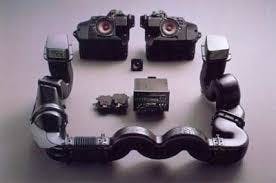
Perhaps the best example of Bose’s bespoke engineering is the third-generation Mazda RX-7 (FD): The subwoofer enclosure snaked around the rear cargo floor!
JBL Audio System (Ford)
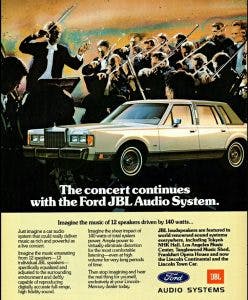
Ford made a marketing misstep in 1980, when it introduced the new Panther-bodied Lincoln Continental and Mark VI with a “Premium Sound” system sporting six speakers. Even the dashboard was festooned with a “Premium Sound”-branded on/off knob to the left of the head unit. Bragging rights matter in the luxury car game, and the absence of JBL’s signature orange logo was a mistake Ford likely regretted when its crosstown rival got in bed with Bose.
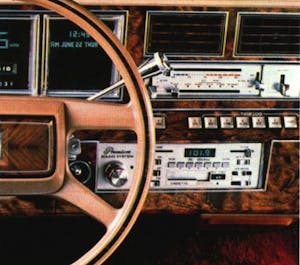
Fast-forward to 1986 and The Blue Oval wised up: Ford’s JBL Audio system was optional for all Lincolns. The system boasted 40 more watts more than the Bose system and was comprised of a gray-faced JBL head unit and two- or three-channel JBL speakers at each corner. The beefy 6×9-inch ’woofers in the rear package tray sported unique metal grilles with Ford-JBL emblems so passersby knew you splashed the cash for better audio. By 1988, a gee-whiz CD player was available. In 1989 the JBL partnership spread deeper across Ford’s product portfolio, but in 1997 Ford cut corners engineered its own Mach Audio system.
Lincolns soldiered on with milquetoast Alpine systems during this time—having learned the perils of the Premium Sound Knob—before all Fords reverted to the audio branding game: first with Sony, and then with Bang & Olufsen (Ford) or Revel Audio (Lincoln). JBL wasn’t losing any sleep on the dissolved partnership with Lincoln; as part of a larger company (Harman International) it quickly partnered with Toyota and, later, Ferrari.
Nakamichi + Lexus

The hi-fi audio branding game kicked into overdrive when a feisty Japanese luxury upstart came on the scene in 1990. Lexus partnered with Nakamichi, a company known for having the best cassette tape decks in home hi-fi systems in the 1970s and ’80s. The rest of Nakamichi’s product range was no joke, either, and Lexus knew what it had to do.
The audio upgrade included a unique head unit (with three-band equalizer), component mid-range and tweeter speakers in the front doors, a full-range speaker for each rear door and a dedicated subwoofer in the rear package tray, brilliantly integrated into the rear stop light (CHMSL). Nakamichi used some unique designs (like a 5-ohm subwoofer), however, which makes many replacement parts impossible to find.
Lexus abandoned Nakamichi for Mark Levinson (part of Harman International) in the 2000s … perhaps because Toyota added Harman’s JBL subsidiary in the late ’90s?
Burmester + Bugatti
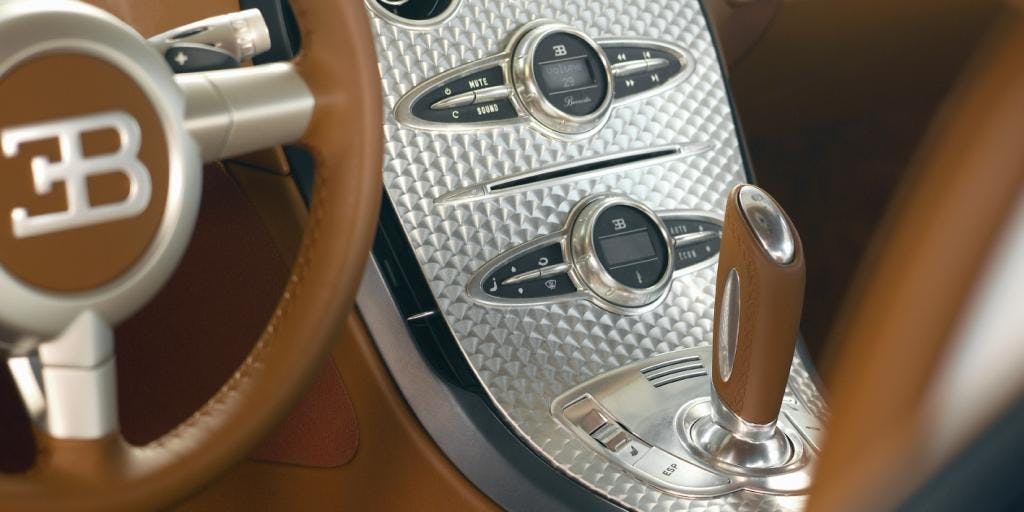
One of the few “modern” audio partnerships that really made waves across the industries is the Burmester audio system for the 2005 Bugatti Veyron. Details are impossible to find, but the engineering partnership was strong enough to influence both Mercedes and Porsche to hop on the Burmester bandwagon. There’s plenty of hype and flash at a Burmester price point (the new Chiron has diamond-encrusted speakers!) but the sound quality was excellent and easy to use.
My personal take: I spent fleeting moments inside a Bugatti Veyron, and the clarity and imaging at low volume easily fill the cabin, to the point that I felt I was in a much bigger space. Yes, the engineering in that car is legit.
harman/kardon + BMW
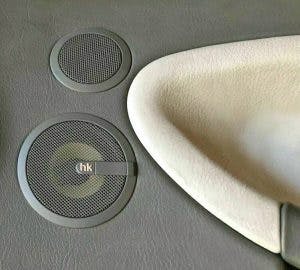
BMW bucked the trend of Bose audio upgrades (take that, Mercedes!) by originally partnering with harman/kardon for the 1995 BMW 3 Series (E36). The end result was sonically impressive by 1980s standards, but the game truly advanced in the next decade: Manufacturers needed bigger, cleaner amplifiers and dedicated subwoofers to stay competitive by the mid-’90s.
The E36’s optional harman/kardon setup included three-way separate component speakers up front (two speakers in the door, a larger driver in the kick panel), upgraded rear speakers, and a unique amplifier. None of these speakers were large enough (or mounted in a fancy Bose enclosure) to handle the bass available in popular music at the time, but perhaps the choice says more about BMW’s long-standing resistance to high-fidelity than it does about the quality of harman/kardon’s engineering.
Infinity Systems + Chrysler

Chrysler was a bit late to the Big Three’s hi-fi party, but its 1987 partnership with Infinity Systems replaced the already respectable Ultimate Sound system. Both old and new designs had a period-appropriate five-band graphic equalizer, and Infinity’s implementation was first introduced in the H-body Dodge Lancer sports sedan. The design was closer to Ford/JBL than to Delco-Bose and comprised of a more conventional arrangement: six Infinity speakers spread between the factory dash, front doors, and rear package tray.
Details on Chrysler’s Infinity Systems setup are harder to find, possibly for good reason: A technical service bulletin from the era suggests that output was 88-watts, or 8 watts more than Ford’s mid-level Premium Sound. These stats are underwhelming, but only on paper.
The 1990s saw the release of Infinity II and Infinity Gold audio systems, while Chrysler in the 2000s transitioned to Boston Acoustics-branded audio. Fear not, however: Infinity speakers made their way to Hyundai and Kia (though never to the Japanese brand with a similar name).
Bang & Olufsen + Audi

Bang & Olufsen (B&O) home audio systems were famous for pairing gimmickry high style with high-end audio performance (unfortunately, one could buy the same quality audio for less or even better sound for the same price). But who cares when B&O is making a system for the range-topping 2005 Audi A8?
Tweeters for this application were pure B&O magic: Reportedly based on the BeoLab 5 loudspeakers, the front tweets raised from the dashboard when needed. Other speakers (above) sported billet aluminum covers. In total there were 14 speakers with over 1000 watts to feed them. Sound quality was fantastic, provided you didn’t expect cabin-shaking bass.
Everyone noticed Audi’s success: B&O systems found homes with Aston Martin, BMW, Mercedes and even Ford. It’s hard to believe the brand that made the Beocenter 9500 also put its name on the 2018 F-150’s wholeheartedly disappointing system, but perhaps this explains why Harman International has owned B&O since 2015 … and not since 2005?
AccuSound by Jensen (AMC)
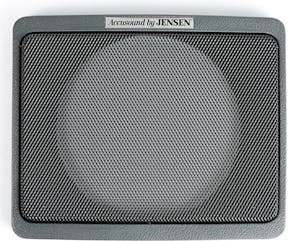
American Motors jumped on the branded-audio bandwagon in 1987 for its flagship Grand Wagoneer. The audio system adds another cool element to the original luxury SUV: Well before it was cool to have a posh truck, Jeep sported AccuSound by Jensen in its decadent cabin. This setup included four co-axial speakers with Jensen’s signature blue surrounds, four unique speaker grilles (above), and a Jeep-branded stereo of unknown wattage.
While not exactly what you see below, AccuSound by Jensen was likely related to these 80-watt speakers:
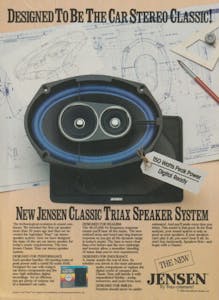
Jensen Electric was never known for audiophile-quality upgrades, but remember this sound-system upgrade went into a truck that dated back to 1963. (Also consider AMC’s dire financial condition at the time!) However, with Cadillac levels of sound insulation and all that ridiculous shaggy carpeting, perhaps AccuSound by Jensen was good enough for the original Grand Wagoneer.
Beats by Dr. Dre + Chrysler
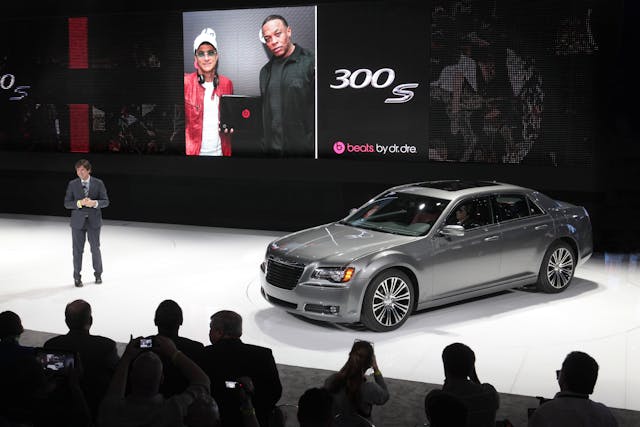
Chrysler gets on the list twice? While Beats turns a profit on overpriced headphones, its in-car audio systems were at least relatively affordable. This partnership, much like GM’s Monsoon Audio, represents a guilty pleasure for those who love bass at the expensive of overall sound quality. Beats Audio premiered in the redesigned 2011 Chrysler 300 with a 522-watt, 12-channel amplifier paired with 11 speakers and “unique equalizer algorithms” developed by Dr. Dre and noted music industry personality Jimmy Iovine. The end result is akin to Bill Blass slapping a few colors on a Lincoln Continental, but hey, it sold headphones to the masses.
Though we damn it with faint praise, more prestigious vehicles have licensed “higher-end” audio nameplates that are subjectively worse than the Chrysler/Beats combo. This estimation depends on whether you’re all about that bass, no treble.
McIntosh Labs + Subaru
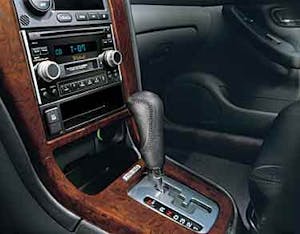
Audiophiles shouldn’t be too excited about the McIntosh audio systems available on higher-trimmed Subarus, because neither did their amplifiers have vacuum tubes nor were there old-school VU meters with that signature blue lighting. These McIntosh units were likely made by Clarion but featured a quality look and feel that matched McIntosh’s lust-worthy home audio. Subaru’s implementation had four McIntosh-engineered door speakers (150 watts of power) and a 72-watt, 6×9-inch subwoofer.
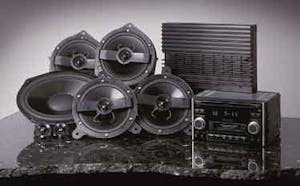
Less notable (but possibly more desirable) is the McIntosh setup in Ford’s 2005 GT supercar. Unfortunately, the subwoofer’s location (right next to your ear) meant the cabin’s acoustics were severely compromised, and audio quality suffered—a far cry from the Burmester setup in the Bugatti Veyron. While McIntosh took a lengthy hiatus from the car world, it’s likely come via partnership with Jeep for the upcoming Grand Wagoneer.
Honorable mention: everyone else
Did we miss your favorite audio + automaker mashup? Please accept our apologies to Naim and Bentley or to Volvo/DynAudio, Land Rover/Meridian, GM/Monsoon, VW/Fender, and even Mitsubishi/Kicker. But take comfort in the fact that precious few of these setups can match or surpass what you can get in the aftermarket … for a fraction of the price.
The reality is that automakers will nickel and dime the audio vendor to meet their price points. (Though the strategy is less of a concern if we’re talking about the A8’s B&O system, and a complete lie when it comes to Veyron customers.) But for everyone else looking for an easily-digestible upgrade on more approachable vehicles, look elsewhere for better tunes in your ride. Provided you don’t buy the cheapest equipment available, you’ll probably love the upgrade.

